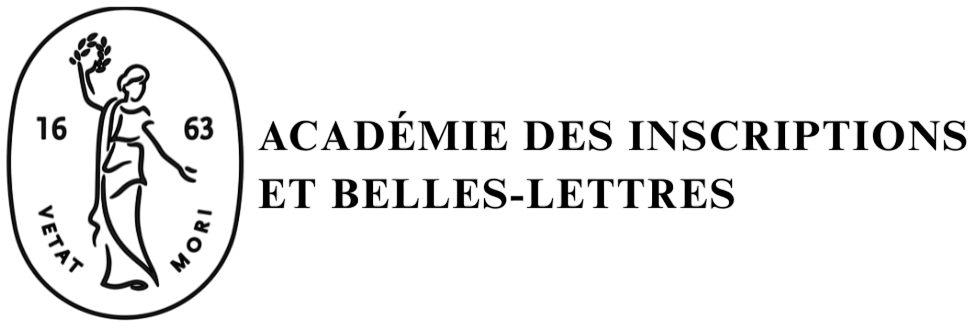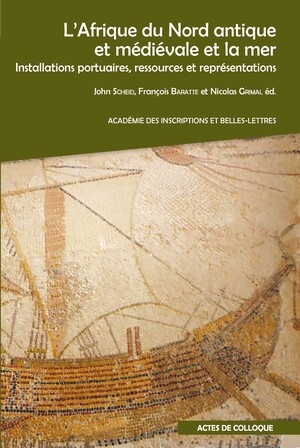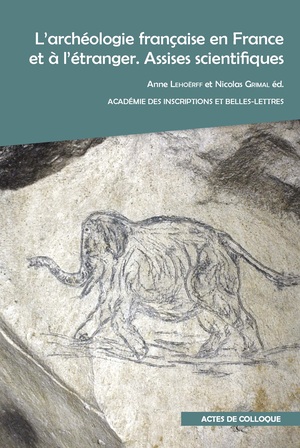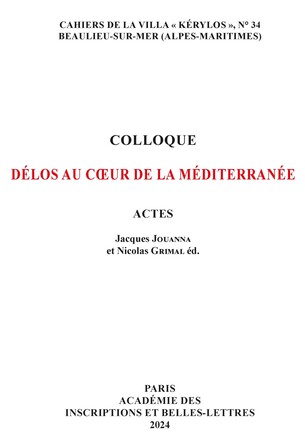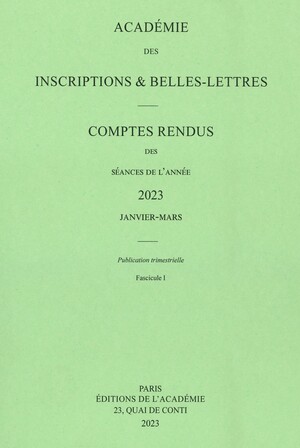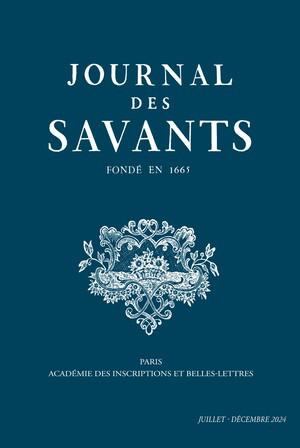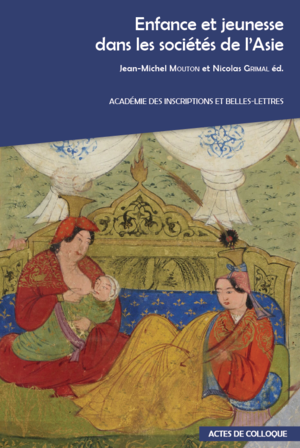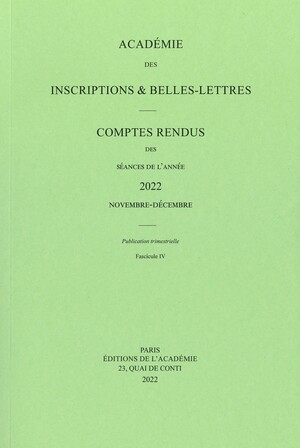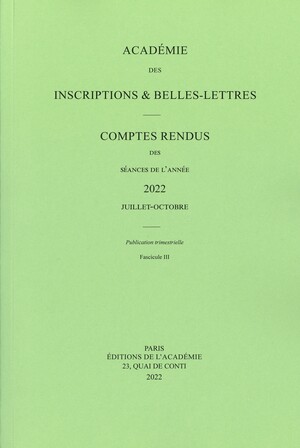Publications Journal des Savants : Juillet-Décembre 2020

Présentation
«La convention financière entre Drymos de Phocide et la confédération des Oitaiens», par Denis ROUSSET, correspondant de l’Académie.
Découvert il y a quelque 140 ans par M. Beaudoin, le document attestant l’emprunt de Drymos à la confédération des Oitaiens est une des plus longues inscriptions de la Phocide antique, et il fut à ce titre souvent reproduit, cité ou commenté dans les recueils dialectologiques et institutionnels et dans les études sur les finances de la Grèce ancienne. En effet, ce document éclaire les rapports entre une cité débitrice et une confédération étrangère, qui est sa créancière ; c’est l’une des rares inscriptions non-delphiques qui touchent à la chronologie de Delphes et des magistrats fédéraux phocidiens, et une source majeure sur la géographie et les institutions de la confédération des Oitaiens, installée autour du mont Oita près des Thermopyles. Cependant, depuis sa publication princeps et sa reproduction presque telle quelle dans les Inscriptiones graecae IX 1 (1897), nos 226-230, ce document est resté mal établi en raison des conditions de conservation du bloc inscrit. Or, un nouveau déchiffrement, depuis peu devenu possible, permet des progrès sensibles dans la compréhension et la chronologie des opérations de rééchelonnement et de remboursement de la dette, amène à préciser notre connaissance prosopographique des diverses parties prenantes et conduit également à faire justice de l’idée, naguère soutenue, que l’Amphictionie pylaio-delphique ait été peu ou prou mêlée à l’emprunt contracté par la cité de Drymos.
A document discovered some 140 years ago by M. Beaudoin, which attests to the loan made by the league of the Oitaians to Drymos, is one of the longest inscriptions from ancient Phocis. For that reason it has been often reproduced, cited or commented on in works on Greek dialects and institutions and in studies of ancient Greek finances. This document, while throwing light on the relationship between a debtor-city and a foreign league as its creditor, is also one of those rare inscriptions which, though not itself Delphic, is of relevance for Delphic chronology and the chronology of the federal magistrates of the Phocians, as well as being a major source for the geography and institutions of the league of the Oitaians located around Mt. Oita near Thermopylai. Even so, since its first publication and its virtually unchanged reproduction in the Inscriptiones graecae IX 1 (1897), nos 226-230, the text of this document has not been well-founded because of the condition of the block on which it is inscribed. But a new autopsy of the stone has recently been made possible and this has allowed for considerable progress in our understanding of the chronology of the rescheduling and reimbursement of the debt. It has also improved our knowledge of the prosopography of the participating parties and has led to a refutation of the previously held idea that the Pylaio-Delphic amphictyony was somehow involved in the loan contracted by the city of Drymos. (transl. R. van Bremen)
«La lente dissolution de la bibliothèque grecque du cardinal Salviati», par Don Giacomo CARDINALI.
Une fois reconnues, classées et illustrés les différentes marques de possession des livres grecs du cardinal Jean Salviati (1490-1553), tantôt manuscrits tantôt imprimés, il a été possible de retrouver plusieurs volumes de cette collection dans les fonds de la Bibliothèque Apostolique Vaticane, mais aussi dans d’autres bibliothèques italiennes, françaises, anglaises et allemandes. La reconstruction de l’histoire de la dispersion de cette très riche et exquise collection de livres a permis aussi de contribuer à l’étude de la formation de la bibliothèque de Pierre Séguier et de la carrière de deux copistes jusqu’aujourd’hui très peu connus : Georges Balsamon et Michael Hermodorus Lestarchos.
By identifying, classifying and illustrating different signs of possession of Greek books, both manuscript and printed, belonging to Cardinal Giovanni Salviati (1490-1553), it was possible to reconnect to the same collection many volumes currently preserved in the Vatican Library, as well as in numerous others libraries in Italy, France, the United Kingdom and Germany. The history of the dispersal of such rich and exquisite collection also allowed retracing the origin of part of Pierre Séguier’s Greek library and the study of the career of two still quite unknown scribes: George Balsamon and Michael Hermodorus Lestarchos.
«« Le Par(ad)is perdu ». La correspondance entre Georgi Mihailov et Louis Robert (1947-1967)», par Dan DANA.
Une partie de la correspondance savante entre deux épigraphistes majeurs du XXe siècle, Louis Robert (1904-1985) et Georgi Mihailov (1915-1991), est éditée et commentée dans cet article. De leur échange épistolaire, malheureusement incomplet, 17 lettres (dont 15 de Mihailov, et seulement deux de Robert) ont été trouvées dans les archives de Paris et Sofia. Elles permettent de suivre leur collaboration pendant les deux décennies d’après la fin de la Seconde Guerre mondiale (1947-1967), dans une période éprouvante pour les intellectuels du « camp socialiste » ; leurs envois étaient parfois accompagnés de livres, tirés à parts, manuscrits et photos. La correspondance publiée ici, corroborée par d’autres témoignages, illustre les liens personnels et savants cultivés par les deux épigraphistes, en particulier pour les notices du Bulletin Épigraphique du redoutable savant français et pour la préparation du corpus des inscriptions grecques de Bulgarie (IGBulg) par l’historien de Sofia, formé à Paris.
A part of the scholarly correspondence between two major epigraphists of the XXth century, Louis Robert (1904-1985) and Georgi Mihailov (1915-1991), is edited and commented in this article. From their epistolary exchange, unfortunately incomplete, 17 letters (including 15 from Mihailov, and only two from Robert) were found in the archives of Paris and Sofia. They allow to follow their collaboration during the two decades after the end of the Second World War (1947-1967), in a challenging period for the intellectuals of the “socialist camp”; their mailings were sometimes accompanied by books, offprints, manuscripts and photos. The correspondence published here, corroborated by other testimonies, illustrates the personal and scholarly links cultivated by the two epigraphists, in particular for the notices of the Bulletin Épigraphique of the redoubtable French scholar and for the preparation of the corpus of Greek inscriptions from Bulgaria (IGBulg) by the historian from Sofia, trained in Paris.
«Un diplôme inédit de Hugues Capet, a. 991 : un nouveau dernier diplôme royal franc pour les comtés catalans ?», par Adam KOSTO.
Bien que des historiens aient constaté l’existence d’un diplôme inédit de 991 de Hugues Capet au monastère catalan de Sant Pere de Rodes, confirmation presque verbatim d’un don antérieur de 953 par Louis IV, personne ne l’avait soumis à une analyse critique. Une telle analyse, que nous offrons ici, ne donne pas de preuves positives qu’il s’agit d’un faux, des points de vue de la date, de la prosopographie, des formules, ou de la typologie documentaire. L’ajout du mot castrum à la description du bien représente une énigme, mais il n’est pas un argument décisif en faveur ou en défaveur de l’hypothèse de la falsification. L’échec des érudits que l’on sait avoir travaillé dans les archives de Sant Pere de Rodes avant leur disparition au commencement du XIXe siècle ne pèse pas non plus, étant donné les aléas de la transmission documentaire. Nous soutenons donc qu’on doit considérer ce diplôme comme authentique. Si nous avons raison, il montre que la série des diplômes royaux francs pour les comtés catalans ne s’arrête pas en 987, ni le contact entre les comtés et la cour royale en 988, comme on le présume généralement – des faits qui jouent un rôle important dans historiographie comme dans la mémoire historique de la Catalogne.
While earlier scholars have noted the existence of an unpublished 991 diploma of Hugh Capet to Sant Pere de Rodes, a near-verbatim confirmation of an earlier grant of Louis IV from 953, none subjected it to critical analysis. Such an analysis, offered here, does not provide positive evidence that it is a forgery, from the perspective of dating, prosopography, formula, or documentary typology. The addition of the term castrum to the description of the grant is a puzzle, but does not weigh heavily one way or the other in the analysis. The failure of antiquarians known to have worked in the archive of Sant Pere de Rodes before its dissolution in the nineteenth century also does not weigh heavily, given the vagaries of documentary transmission. I argue, therefore, that this should be considered a genuine diploma. If it is, it shows that the series of French royal diplomas did not cease in 987, nor did contact between the Catalan counties and the French royal court in 988, as is generally understood to be the case—a fact that plays a prominent role in the historiography and historical memory of Catalonia.
«L’inscription sanscrite de Lovek au Cambodge», par Pierre-Sylvain FILLIOZAT, membre de l’Académie.
L’inscription sanscrite dite de Lovek, lieu présumé de son origine, a pour objet de relater la donation d’une statue et d’un palanquin à un temple dans Dviradapura au Cambodge par Śaṃkara Paṇḍita, chapelain des trois grands rois du royaume khmer qui ont rempli presque tout le XIe siècle de notre ère, Sūryavarman Ier (1002-1050), Udayādityavarman II (1050-1066), Harṣavarman III (1066-1080). L’acte de donation est formulé dans la dernière strophe du texte en sanscrit, puis en khmer dans un appendice énumérant toutes les donations pieuses faites par le donateur au cours de sa longue carrière de chapelain royal. Cela est précédé d’un long panégyrique du personnage et de sa famille, dont plusieurs membres de génération en génération au long de trois siècles (du IXe au XIe), ont exercé d’importantes fonctions à la cour royale. La charge la plus haute, et la plus influente, parce que la plus proche du pouvoir, a été celle de guru, aussi appelé hotṛ ou purohita, maître dirigeant les rites royaux et conseiller personnel du roi. Il devait avoir une compétence dans trois domaines, pratique du rituel, érudition en langue, littérature et scolastique sanscrites, service du dharma, bon ordre en morale, droit et coutume profane et religieuse. Śaṃkara Paṇḍita fut le guru accompli dans les trois sphères. La conception théologique et l’ordonnancement du temple-montagne du Baphuon doivent lui être attribués aux côtés de Sūryavarman Ier et Udayādityavarman II. Il officia lors de la grande cérémonie d’installation d’un Liṅga d’or dans le sanctuaire sommital du Baphuon, qui est le second monument en taille, complexité et prestige après Angkor Vat. Ce texte est composé dans le style de la poésie savante sanscrite. Il est manifeste qu’une inscription sanscrite est composée au Cambodge, comme en Inde, avec égalité de méthode et d’esprit. Mais l’application des connaissances issues des sources indiennes dans la pratique religieuse et dans les arts au Cambodge est manifestement khmère. Il n’en reste pas moins que la grandeur et la beauté de la conception, comme de la réalisation, sont également partagées entre la stèle inscrite et le monument. Une bonne approche des inscriptions sanscrites du pays khmer est sans conteste la confrontation du texte avec la discipline sanscrite de l’ornementation poétique (alaṃkāraśāstra) et la littérature religieuse tantrique de l’école du Śaivasiddhānta.
The sanskrit inscription of Lovek, presumed place of its origin, records the donation of a religious icon and a palanquin to a temple in Dviradapura in Cambodia by Śaṃkara Paṇḍita, guru of three glorious rulers of the Khmer kingdom in 11th century CE, Sūryavarman I (1002-1050), Udayādityavarman II (1050-1066), Harṣavarman III (1066-1080). The donation act is formulated in the last stanza of the Sanskrit text and in an appendix in Khmer listing all the religious gifts done by the donator during his many years of royal service. That is preceded by a long panegyric of the person and his ancestors, among whom several individuals, from generation to generation along three centuries, 9th to 11th CE, performed important functions in the royal court. The highest function and the most influential because of its proximity to the king, was that of guru, also called hotṛ or purohita, teacher executing the royal rituals, and councillor of the king. The guru had competence in three fields, ritual practice, erudition in the Sanskrit language, literature and scholasticism, obedience to dharma, righteousness in morals, secular and religious law and customs. All is exalted in the personality of Śaṃkara Paṇḍita. The theological conception and the layout of Baphuon mountain-temple are ascribable to him at the side of Sūryavarman I and Udayādityavarman II. He directed the rituals of installation of the Gold Liṅga in the top shrine of Baphuon which is second in size, complexity and prestige after Angkor Vat in Cambodia. This text is composed in the scholarly style of Sanskrit poetry. It is clear that a Sanskrit inscription is composed in Cambodia, like in India, with the same method and spirit. But the application of the knowledge derived from Indian sources in religious practice and arts in Cambodia is Khmer. Nevertheless the grandeur and beauty of conception and realization are equally shared by the inscribed stela and the monument. A good approach of the Sanskrit inscriptions of the Khmer kingdom will be through a confrontation with the rules of the Sanskrit discipline of poetical ornamentation (alaṃkāraśāstra) and with the ritualistic literature of the Tantric movement of Śaivasiddhānta.
«Les premiers exploits en mer des frères Barberousse», par Nicolas VATIN, membre de l’Académie.
On a longtemps mal connu la chronologie des premières années d’activité corsaire des frères Oruç et Hayr ed-Dîn Barberousse. Pourtant, établir aussi précisément que possible la datation de leurs faits et gestes est essentiel pour les replacer dans leur contexte historique. Le présent article s’efforce donc de suivre les débuts en mer des Barberousse, dans les années 1510-1516, d’abord au Levant, puis en Occident.
Les sources, espagnoles, italiennes et ottomanes, ne manquent pas. Chacune a ses biais et ses défauts, mais leur confrontation permet d’y voir plus clair. Un document ottoman bien connu, quoique pas toujours estimé à sa juste valeur, est la biographie commandée dans les années 1530 par Soliman-le-Magnifique et connue sous le nom de Ġazavât-ı Hayr ed-Dîn Paşa (Geste de Hayr ed-Dîn Paşa). Un des intérêts de la présente étude est de confirmer qu’il s’agit d’une source d’une qualité remarquable qu’il importe de toujours prendre au sérieux. Sans prendre au pied de la lettre ce récit de propagande rédigé vingt ans après les événements, on peut estimer qu’il a le plus souvent pour fondement une réalité historique, que le croisement avec d’autres sources permet parfois de restituer.
Enfin, on constate que malgré leur activité, les deux frères demeurèrent un certain temps des pirates anonymes pour les Occidentaux. L’affaire de la nave de Gasparo di la Cavaleria, en mai 1514, dut marquer les esprits, mais c’est en mai 1515 qu’apparaît pour la première fois le nom des Barberousse dans les Diarii de Marino Sanudo. Désormais, leur célébrité ira s’amplifiant, mais c’est furtivement, à petit pas, qu’ils étaient entrés dans l’histoire.
For a long time, the chronology of the first years of the Barbarossa brothers Oruç and Hayr ed-Dîn’s privateering activity has not been very well known. However, it is of great importance to date their deeds as exactly as possible if one wants to put them into their historical context. In this paper I try to trace the coming out of the Barbarossas in the years 1510-1516, first in the Eastern and then in the Western Mediterranean.
We have plenty of sources, Spanish, Italian and Ottoman. They all have their bias and deficiencies, but their confrontation allows a better understanding. We possess an Ottoman document which is well known, but whose real value has not always been appreciated: the biography written on Suleiman the Magnificent’s order and known as Ġazavât-ı Hayr ed-Dîn Paşa (The Deeds of Hayr ed-Dïn Paşa). One point of this study is the confirmation of the high quality of this text as a source that should always be taken seriously. If we must not take for granted the details of this propaganda narrative written twenty years after the events, we can prove that it is more than once founded on a historical reality which it is sometimes possible to reveal by confronting it to other sources.
Lastly, we see that in spite of their activity, the two brothers for some time remained anonymous pirates for the Westerners. The affair of Gasparo di la Cavaleria’s nave, in May 1514, probably drew their attention, but it is only in May 1515 that the name Barbarossa appeared in the Diarii of Marino Sanudo. Henceforth their renown began to grow. But they made their way into History without being noticed, step by step.
«La norme comme universel du langage», par Robert MARTIN, membre de l’Académie.
La norme peut se concevoir comme une fonction universelle de contrôle, attachée à toute langue : de nombreux arguments vont dans ce sens. La norme se présente sous deux aspects.
L’une des fonctions normatives est interne à la langue comme système : la norme contrôle et restreint la puissance en soi illimitée des régularités linguistiques ; elle contrôle aussi les régularités purement locales et qui du fait même s’assimilent à l’irrégularité. On rejoint ainsi les vues de Louis Hjelmslev et de Eugenio Coseriu.
L’autre fonction normative universellement disponible, plus habituellement reconnue, est liée à l’idée de « langue de culture » : la norme suppose alors l’intervention consciente de locuteurs ; elle est indissociable de la notion même de « langue » et se manifeste de dicto.
The norm can be thought of as a universal monitoring function common to all languages. There are many arguments to support this viewpoint. The norm can be seen as twofold.
One of its functions is set within language as a system so that on the one hand it monitors and restricts the unlimited regularities a language has and, on the other, it controls purely local regularities which can thereby be assimilated to irregularity. This aspect echoes the viewpoints of Louis Hjelmslev and Eugenio Coseriu.
The other normative function which is universally avaibable and more usually recognized is inherent in the idea of a “language of culture”: the norm presupposes that speakers consciously act on language. It is indissociable from the very idea of language and made manifest de dicto.
